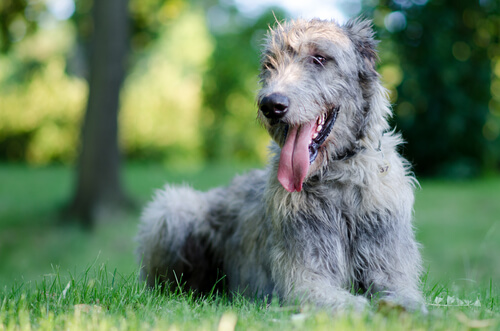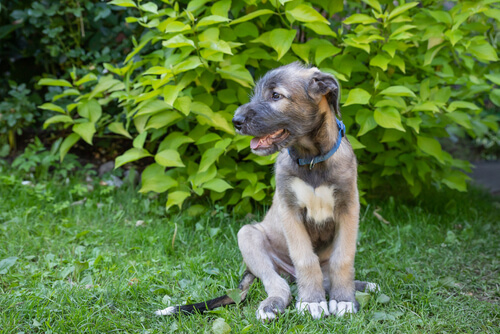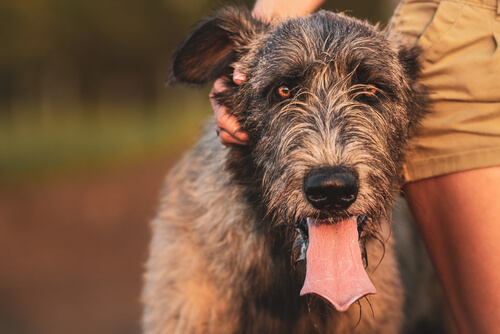
| Kingdom | Animalia |
| Phylum | Chordata |
| Class | Mammalia |
| Order | Carnivora |
| Family | Canidae |
| Genus | Canis |
| Species | C. lupus |
| Species | C. lupus familiaris |
| Niche | Domestic |
| Height | 30-34 inches (76-86 cm) |
| Weight | 90-120 lbs (50-55 kg) |
| Lifespan | 6-10 years |
| Social Structure | Social, domesticated |
| Breed Status | Common (77th of 155 AKC recognized breeds) |
| Preferred Habitat | Domestic |
| Average Litter Size | 2-12 puppies |
| Main Food Item | Dog Food |
The Basics
A wolfhound is a group of large domestic dog breeds that were used as hunting dogs. Known for their large size, wolfhounds were used to pursue game using their speed to their advantage. They are also known as guardian dogs, and exist in various modern-day varieties, including the Irish Wolfhound.

Irish Wolfhounds are among the tallest dog breeds, standing between 30-34 in (76-86 cm) at its withers and weighing up to 120 lb (54.5 kg). They are the largest galloping hounds and have coarse, medium-lengthed overcoats that are typically grey, brindle, or other colors such as fawn and wheaten. Wolfhounds are strong and lean. They are also agile for their size due largely to their relation to Greyhound-like breeds. Thus, they are relatively light for their large frames. They have long torsos and a long neck that typically holds their head high and proud.
Wolfhound-like dogs have been used as hunting dogs for centuries, dating back to ancient Rome and use by ancient Irish peoples in the 6th century. Irish wolfhounds were kept only by kings and noblemen. The number allowed was regulated, with more being permitted to people of higher status.

After nearly disappearing altogether following the extinction of large game in Ireland by the 1700s, the breed was revived from just a few remaining wolf dogs. In 1885, Captain George Augustus Graham founded the Irish Wolfhound Club and the breed was finally recognized by the American Kennel Club in 1897 and by the English Kennel Club in 1925. Currently, the breed is quite popular, ranking 77th of 155 among breeds currently recognized by the American Kennel Club.
Temperament as Pets
Wolfhounds tend to be unique individuals, with personality types depending more on the specific dog than the breed itself. However, they are far from aloof, typically being very attentive and alert. They are also generally introverted and reserved, if not a little shy of unfamiliar people and other pets. As long as they receive a moderate amount of exercise, they are rarely destructive despite their large size and strength. They are known to shed although not excessively and require only a moderate amount of care, such as weekly brushing and occasional baths.
Despite their independence and intelligence, wolfhounds form strong bonds with their families and are not happy being left alone often. They will also form this type of bond with other pets that they live with, particularly other dogs. Wolfhounds are usually docile and friendly, even to strangers, but can become fierce personal guardians if they perceive their owners to be in danger. Their gaming instinct is strong, so a fence large enough to contain their tall stature may be required to avoid them chasing wildlife and small animals they spot.

Irish wolfhound Females typically give birth to litters of about 2-12 puppies. Puppy coats are typically more brown than grey and are softer and shorter than those of adult wolfhounds. They are prone to various health issues such as hip and elbow dysplasia and heart disease. Like other large breeds, the wolfhound’s lifespan is relatively short. Most individuals live for only about 6-10 years old.
Fun Facts about Wolfhound!
From war dogs to wolf hunters to beloved pets to lure course champions, the wolfhound has been around for centuries in one form or another and is a fascinating breed to explore further.
Wolf Hunting War Dog
Wolfhounds were guardians against wolves and were also used to hunt them. Furthermore, ancient versions of the breed were even used as war dogs. They would accompany armies into war and drag combatants from their chariots and horses. Luckily, with dogs being long outdated as war weapons, modern versions of the breed are more likely to be found competing in dog shows and competitions.
What Came First?
Domestic dogs have evolved from wolves and other wild dogs that were domesticated by humans over centuries. Ironically perhaps, the wolfhound was bred to hunt wolves and to protect people from wolves in places like Ireland and Russia. Even more ironically though, the last wolf in Ireland was killed in 1786 by a back of wolfhounds. Without any more wolves to kill, the Irish wolfhounds that remained were more status symbols than hunters. These become the last of their kind.
Modern Irish wolfhounds were revived in the 1800s via selective breeding efforts aimed to recreate a similar breed as ancient wolf dogs by breeding the Scottish Deerhound and Great Dane. As both breeds themselves are descendent of historic wolf dogs, there was some logic to this. Indeed, DNA analysis revealed that the modern Irish wolfhound shares genes with the deerhound, whippet, greyhound, and, primarily, the Great Dane.
